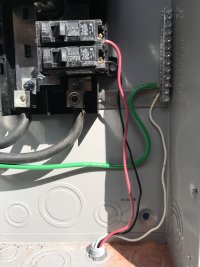steveray
SAWHORSE
This was found in a medical facility when the wall was opened up to extend a nurses station.
NEC Violations are:
I am sure you can see even more.... What else is there?
View attachment 3291
517 for health care wiring?
Your premier resource for building code knowledge.
This forum remains free to the public thanks to the generous support of our Sawhorse Members and Corporate Sponsors. Their contributions help keep this community thriving and accessible.
Want enhanced access to expert discussions and exclusive features? Learn more about the benefits here.
Ready to upgrade? Log in and upgrade now.
This was found in a medical facility when the wall was opened up to extend a nurses station.
NEC Violations are:
I am sure you can see even more.... What else is there?
View attachment 3291
This was found in a medical facility when the wall was opened up to extend a nurses station.NEC Violations are:
why should the first hole be 11 inches off the track?

View attachment 3273 View attachment 3274
This is a demo and rebuilding on existing foundation. This panel is live.
Openings to be closed NEC312.5 (A) and a few other things.
The lug is attached with the wrong screw. The lug is barely in contact with the surface. Scratching paint is not the same as removal. The paint shall be removed for the entire area of contact.250.12 Clean Surfaces. Nonconductive coatings (such as
paint, lacquer, and enamel) on equipment to be grounded
shall be removed from threads and other contact surfaces to
ensure good electrical continuity or be connected by means of
fittings designed so as to make such removal unnecessary.
View attachment 4018
The lug is attached with the wrong screw. The lug is barely in contact with the surface. Scratching paint is not the same as removal. The paint shall be removed for the entire area of contact.
Do you have an issue with this? I would be OK with it...........
Looks like a nut and bolt.........you would require complete removal of finishes....sparky has to have a grinder on hand?
All electricians I know carry a grinder. As an electrician a grinder is of of the more used tools in my truck.
Yup
And 2 different wire wheels and touch up paint. As an installer if one of my guys did what is pictured, he would be taking that apart and he would get an education in how easy it is to do it right.
Come to think of it, I am trying to figure out what Norm doesn't do with a grinder.... LOL
I watched him slice cheese for his sandwich with his grinder today.
1. grounded conductor and equipment grounding conductor bonded
2. grounded conductor marked wrong
3. equipment grounding conductor marked wrong
